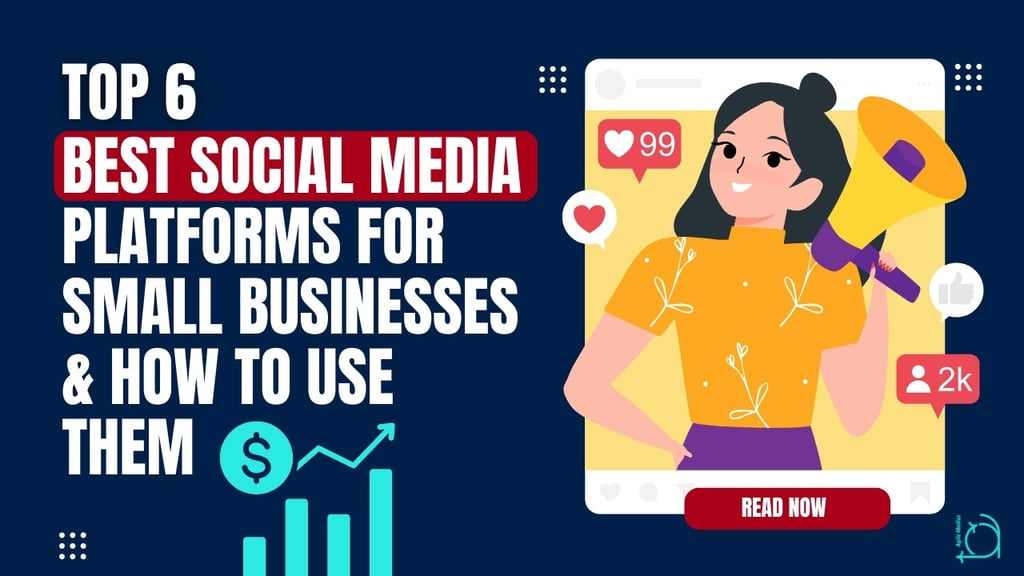Top 6 Best Social Media Platforms for Small Businesses & How to Use Them
A comprehensive guide to choosing the best social media platforms for small businesses, with practical strategies on how to use each platform effectively for growth and engagement.
SOCIAL MEDIADIGITAL MARKETING TIPSONLINE BRANDINGCONTENT CREATIONDIGITAL MARKETINGSMALL BUSINESS
Agile Mediaz
1/5/20254 min read


Social media is one of the most powerful tools for small businesses today. Whether you're looking to build brand awareness, attract customers, or increase sales, the right platform can make all the difference. But with so many options, it’s easy to feel overwhelmed.
The key? Don’t try to be everywhere—be where your audience is. Choosing the right social media platform can save you time, effort, and even money while delivering real results for your business.
Let’s break down the best social media platforms for small businesses, what they’re best for, and how to make the most of them.
1. Facebook – Best for Community Engagement & Ads
Facebook remains one of the best platforms for small businesses, especially if you’re focused on building relationships with customers. With nearly 3 billion active users, it offers powerful tools for growing an engaged community and running targeted ads.
How to Use Facebook for Your Business:
Create a Business Page – Make sure your page is complete with business info, services, and a compelling description.
Join & Engage in Groups – Connect with potential customers by participating in local or industry-specific groups.
Use Facebook Ads – Target specific audiences based on interests, location, and behaviors.
Post Engaging Content – Mix up promotional posts with customer stories, behind-the-scenes content, and live videos.
Best For: Local businesses, e-commerce, service providers, restaurants, and personal brands.
2. Instagram – Best for Visual Storytelling & E-commerce
Instagram is all about aesthetics and storytelling. If your business has visual appeal—whether through products, branding, or lifestyle content—Instagram is a must. Plus, features like Instagram Shopping make it easy for customers to buy directly from your posts.
How to Use Instagram for Your Business:
Post High-Quality Images & Reels – Showcase products, behind-the-scenes moments, or customer testimonials.
Use Stories & Highlights – Give your audience quick updates, tips, or promotions.
Sell Directly on Instagram – Tag products in posts and stories for easy shopping.
Leverage Hashtags & Location Tags – Increase discoverability by using niche-specific hashtags.
Best For: E-commerce, beauty, fashion, fitness, food, and creative businesses.




3. LinkedIn – Best for B2B & Professional Networking
LinkedIn is the go-to platform if your business serves other businesses (B2B) or professionals. It’s ideal for networking, generating leads, and building authority in your industry.
How to Use LinkedIn for Your Business:
Optimize Your Company Page – Fill out all details and share industry insights.
Publish Thought Leadership Content – Post articles, tips, and professional insights.
Network & Connect – Engage with industry leaders, potential clients, and collaborators.
Join & Participate in LinkedIn Groups – Position yourself as an expert by contributing valuable discussions.
Best For: B2B businesses, consultants, agencies, freelancers, and service providers.


4. TikTok – Best for Viral Marketing & Brand Awareness
Think TikTok is just for teenagers? Think again. Businesses across all industries are using TikTok to reach new audiences, go viral, and showcase their personality. If you can create short, engaging videos, this platform is a goldmine.
How to Use TikTok for Your Business:
Create Fun, Engaging Videos – Share how-to tips, behind-the-scenes footage, or industry trends.
Use Trending Sounds & Challenges – Boost visibility by hopping on viral trends.
Collaborate with Influencers – Work with TikTok creators to expand your reach.
Post Frequently & Engage – Consistency is key to TikTok growth.
Best For: Lifestyle brands, food, fitness, education, entertainment, and personal brands.


5. Twitter – Best for Real-Time Updates & Customer Service
Twitter is all about quick conversations and staying in the know. If your business involves news, events, or direct customer interactions, this platform can help you stay relevant.
How to Use Twitter for Your Business:
Engage in Conversations – Reply to comments, answer questions, and join trending discussions.
Share Industry News & Insights – Keep your audience informed with updates and thought leadership.
Run Polls & Contests – Engage your followers in interactive ways.
Use Twitter Ads for Quick Reach – Promote tweets to reach a wider audience.
Best For: News/media companies, tech businesses, public figures, and brands focused on real-time engagement.


6. Pinterest – Best for E-commerce & Inspiration-Based Content
Pinterest isn’t just a social media platform—it’s a visual search engine. People come here to discover new ideas, products, and solutions, making it an excellent platform for businesses that rely on aesthetics or tutorials.
How to Use Pinterest for Your Business:
Create High-Quality, Clickable Pins – Use compelling images and clear text overlays.
Link Pins to Your Website – Drive traffic to product pages, blogs, or landing pages.
Organize Boards by Category – Make it easy for users to browse your content.
Use Pinterest SEO – Optimize your pins with relevant keywords for better visibility.
Best For: E-commerce, fashion, home decor, fitness, food, and blogging.
Final Thoughts: Choose the Right Platform & Stay Consistent
The best social media platform for your business depends on your goals, audience, and content style. Instead of trying to be on every platform, focus on one or two that align with your business needs and master them.
What to Do Next:
Identify where your audience spends the most time.
Choose 1-2 platforms that best fit your brand.
Create high-quality, engaging content tailored to each platform.
Stay consistent and track what works best.
Social media is a powerful, free tool that small businesses can use to grow. The key is strategy over quantity—be intentional, engage with your audience, and have fun with it!


Connect
Empowering small businesses through digital marketing solutions.
Explore
Innovate
contact@agilemediaz.net
© 2024. All rights reserved.

